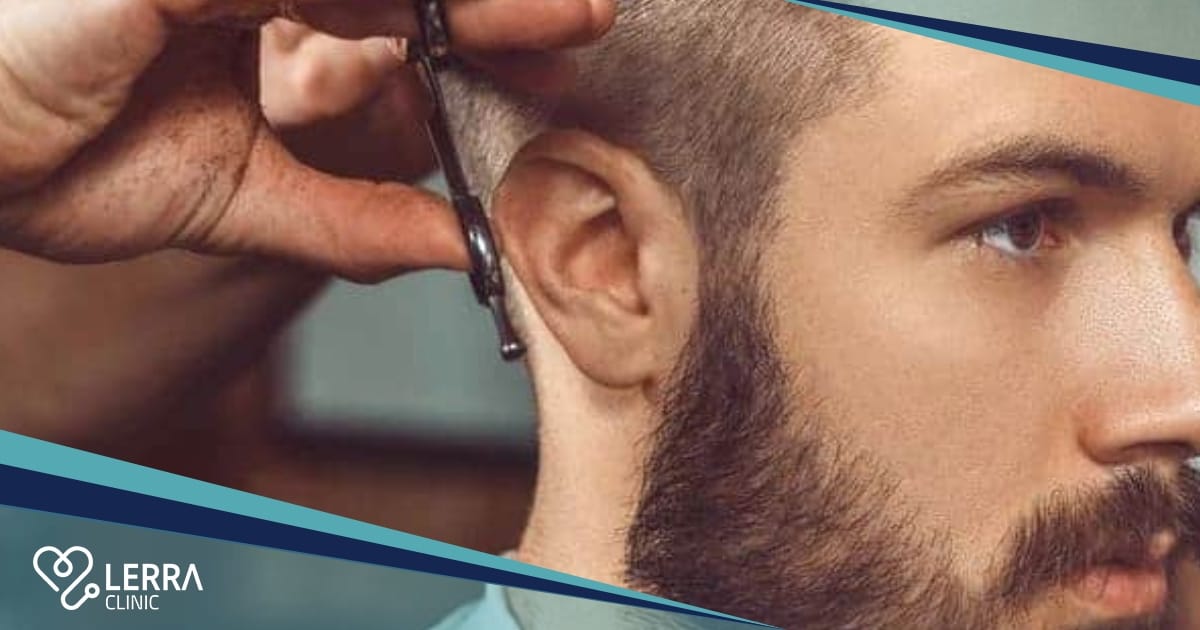Wondering how to style your hair after a hair transplant? This article covers everything from managing newly transplanted hair to understanding the best hairstyles, including the ideal hairstyle after hair transplant, and tips on using the right products and tools for optimal results.
Table of Contents
Key Takeaways
- The initial healing phase after a hair transplant requires gentle care. To protect fragile grafts, avoid vigorous washing and heat sources.
- Shock hair loss is common after a transplant but typically temporary; patients can expect regrowth within three to six months.
- Choosing the right hairstyle that minimizes stress on new grafts and employing mild products are essential for transplanted hair’s long-term health and aesthetics.
Understanding the Initial Healing Phase

The initial healing phase is a delicate period where the transplanted hair grafts are at their most fragile. Handle your hair with extreme care to avoid damaging the new grafts during this period. Consistent daily hair care, such as gentle washing and light scalp massages, promotes blood circulation and supports healing. Hair texture may also change due to the healing process and scar tissue formation.
Post-transplant hair management requires understanding how different hair textures interact with newly transplanted follicles. Curly hair might need more hydration, while straight hair may require careful styling to blend with existing hair.
First Month Care
The first month post-transplant is crucial for the longevity and health of the transplanted hairs. Avoid vigorous washing during this period to prevent dislodging the newly implanted follicles. Heat sources like saunas and blow dryers should also be avoided within the first week post-transplant to prevent scalp sweating and irritation. Patience is key; wait a few weeks before using any styling products to allow your scalp to heal.
Harsh hair products during this period can hinder the healing process. Gentle care practices, like using mild shampoos and avoiding excessive handling, support the healing process and ensure your new hair flourishes.
Shock Hair Loss
Shock hair loss, or shedding, is a common response following a hair transplant. Many hair transplant patients experience noticeable thinning of hair within a few weeks post-transplant. This can be alarming, but shock hair loss is generally a temporary condition. Most people experience regrowth within three to six months, so patience and proper aftercare are important.
Remember, even though the hair might shed, the transplanted hair follicles are still alive and can grow back. This phase is part of the natural hair transplant process. With proper care, new hair growth and a fuller head of hair will soon follow.
When Can You Get Your First Haircut?

A common question after a hair transplant is, “When can I get my first haircut?” It’s advisable to wait at least three weeks before considering your first haircut to ensure grafts have stabilized. However, you can consider a gentle scissor haircut after about ten days if necessary.
Avoid clippers and shaving machines, which can irritate the sensitive scalp and newly transplanted follicles. Initially, use only scissors for cutting new hair to avoid disturbing the delicate follicles. Regular haircuts can typically resume around six months post-transplant, once the grafts are secure and the hair has blended naturally.
Consultation with Your Transplant Surgeon
Consult your transplant surgeon before getting your first post-transplant haircut. They can provide personalized advice tailored to your specific situation and ensure that your scalp has healed properly. Strictly following their hair transplant aftercare instructions is crucial to avoid complications and ensure the best results.
Inform your stylist about your recent hair transplant so they can use appropriate cutting techniques. Most stylists are familiar with cutting hair post-transplant, making the experience smoother and safer.
Signs You’re Ready for a Haircut
Look for specific signs to know if you’re ready for a post-transplant haircut. Reduced redness and swelling in the scalp indicate healing. Absence of scabbing also indicates your scalp is ready for a haircut.
Ensure your scalp feels comfortable and shows no signs of irritation or sensitivity before proceeding with a haircut. Paying attention to these signs will help you avoid any setbacks in your hair transplant journey.
Choosing the Right Hairstyle Post-Transplant

Choosing the right hairstyle post-transplant ensures seamless blending of new and existing hair. Whether you prefer textured curls, comb-overs, or buzz cuts, there’s a wide variety of hairstyles to choose from post-transplant. Consider hairstyles that minimize stress on new grafts and the donor area to ensure transplant longevity.
When your hair begins to grow back, you can style it as before the transplant. Mentioning your hair transplant to your stylist helps them apply the best techniques for your new hair.
Short Haircuts
Short haircuts are popular post-transplant for effectively blending new growth with existing hair, minimizing uneven lengths. A shorter style makes it easier to manage new growth while blending seamlessly with existing hair.
Short haircuts facilitate easier maintenance and help showcase new growth, smoothing the transition during the regrowth phase.
Layered Cuts
Layered cuts add volume and movement by cutting hair at various lengths. During the regrowth phase, layered cuts blend new growth with existing hair for a fuller look.
Styling a layered cut with the right techniques and products enhances its volume and creates a lively appearance.
Buzz Cuts
Buzz cuts are favored post-transplant for low maintenance and creating a uniform look as hair grows. This style is particularly beneficial during regrowth, as it effectively disguises inconsistencies in hair growth.
The simplicity of a buzz cut means less stress on newly transplanted follicles, making it ideal for many patients.
Styling Products and Techniques

The right styling products and techniques are crucial after a hair transplant. Mousse, for example, adds volume and makes hair appear fuller. Choose products that support healthy hair growth and maintain the appearance of your new hair.
Avoid heat treatments and select mild, non-irritating products to significantly impact the health and aesthetics of your transplanted hair.
Avoiding Heat Treatments
Avoid heat treatments like blow-drying and straightening to protect newly transplanted follicles. Heat styling tools can burn the scalp and damage healing follicles, undermining the healing process.
Instead, consider air-drying your hair or using low-heat settings to minimize damage.
Safe Styling Products
Mild shampoos, like baby shampoo, help prevent irritation during the initial healing phase. Specialist shampoos or saline solutions are recommended in the first month post-transplant to maintain scalp health.
Be gentle when washing your hair to protect newly transplanted follicles. Water-based styling products are preferable for providing a light hold without causing buildup.
Dyeing Your Hair
Wait at least six months before dyeing your hair after a transplant. Surgeons recommend avoiding hair dyes and chemicals for at least three weeks post-transplant due to scalp sensitivity.
When dyeing your hair, choose gentle products without irritating chemicals and perform a patch test to ensure no adverse reactions.
Managing Different Hair Types After Transplant

Managing hair post-transplant varies by hair type, as each requires tailored care to promote healthy growth. For curly hair, moisturizing, sulfate-free shampoos prevent dryness and damage. Wavy hair benefits from lightweight creams or gels that enhance natural waves without buildup. Straight hair requires precise graft placement to achieve a natural look and minimize scars’ visibility.
Tailored care for your specific hair type can significantly enhance hair transplant results.
Curly Hair
For curly hair post-transplant, hydration is key. Moisturizing products prevent dryness and support curl definition. A leave-in conditioner helps keep curly hair hydrated and prevents frizz.
A gentle brush on curly hair minimizes stress on newly transplanted follicles, ensuring healthy growth.
Wavy Hair
Enhance natural waves without damaging transplanted areas by using lightweight styling products. Light styling creams that define texture without weighing hair down enhance waves post-transplant.
Consider using lightweight mousse for volume and enhanced natural waves without stressing transplanted hair.
Straight Hair
Straight hair requires precise graft placement to minimize scars’ visibility and achieve a natural look post-transplant. Regular conditioning maintains moisture and manages temporary texture changes post-transplant.
Gentle styling tools and a smooth, sleek style minimize stress on newly transplanted areas, ensuring healthy growth.
Long-Term Hair Care and Maintenance
Ongoing care maintains the health of transplanted hair and supports continuous growth. Consistent hair care routines, like regular trims and mild shampoos, sustain hair health and ensure optimal growth post-transplant.
Incorporate protective measures, like wearing hats or using sunscreen on the scalp, to prevent sun damage.
Regular Trims
Regular trims maintain healthy hair post-transplant. Trimming every six to eight weeks prevents split ends and promotes healthier growth.
Frequent haircuts eliminate split ends, promoting overall hair vitality.
Scalp Health
A healthy scalp environment is vital for hair regrowth. Mild shampoos and avoiding harsh chemicals support scalp health. Light scalp massages stimulate blood flow, enhancing scalp health and promoting growth.
A balanced diet rich in proteins, vitamins, and minerals promotes robust hair health post-transplant.
Nutritional Support
Supplements like biotin or collagen enhance hair strength and thickness post-transplant. Consult a healthcare provider about suitable supplements for beneficial results tailored to individual needs.
Proper nutrition plays a crucial role in the recovery and health of hair post-transplant.
Summary
Navigating the journey of hair care post-transplant can be daunting, but with the right knowledge and practices, you can ensure your new hair thrives. From understanding the initial healing phase to choosing suitable hairstyles and products, every step is vital to achieving optimal hair transplant results. Regular trims, maintaining scalp health, and supporting your hair through proper nutrition will help you enjoy a full head of healthy hair. Embrace this new chapter with confidence and care, and watch your hair flourish.
Contact us today and get the best offer!
Read Also:
Hair Transplant Costs in the UK vs. Turkey: Best Value in 2025?
Top Cutting Edge Hair Transplant Techniques for Optimal Results
The Best All-Inclusive Hair Transplant Turkey Packages
Frequently Asked Questions
When can I get my first haircut after a hair transplant?
You can typically get your first haircut around three weeks after a hair transplant. Gentle scissor cuts may be possible after ten days, but avoid clippers for at least four weeks.
What is shock hair loss, and will my hair grow back?
Shock hair loss is a temporary shedding of hair that often occurs after a hair transplant, but rest assured, most individuals see regrowth within three to six months. Your hair should return to its normal state as the healing process completes.
What kind of styling products should I use after a hair transplant?
After a hair transplant, it’s essential to use mild, non-irritating products like baby shampoos and water-based styling products. Steer clear of harsh chemicals and heat treatments to safeguard the new hair follicles.
Can I dye my hair after a hair transplant?
It’s best to wait at least six months after a hair transplant before dyeing your hair to ensure proper healing. If you opt to dye it sooner, wait four weeks and conduct a patch test first to avoid any adverse reactions.
How can I manage different hair types after a transplant?
To effectively manage different hair types post-transplant, ensure you use products tailored to each type: moisturizing products for curly hair, lightweight creams or gels for wavy hair, and regular conditioning for straight hair. This approach will help maintain a natural look and promote healthy hair growth.

